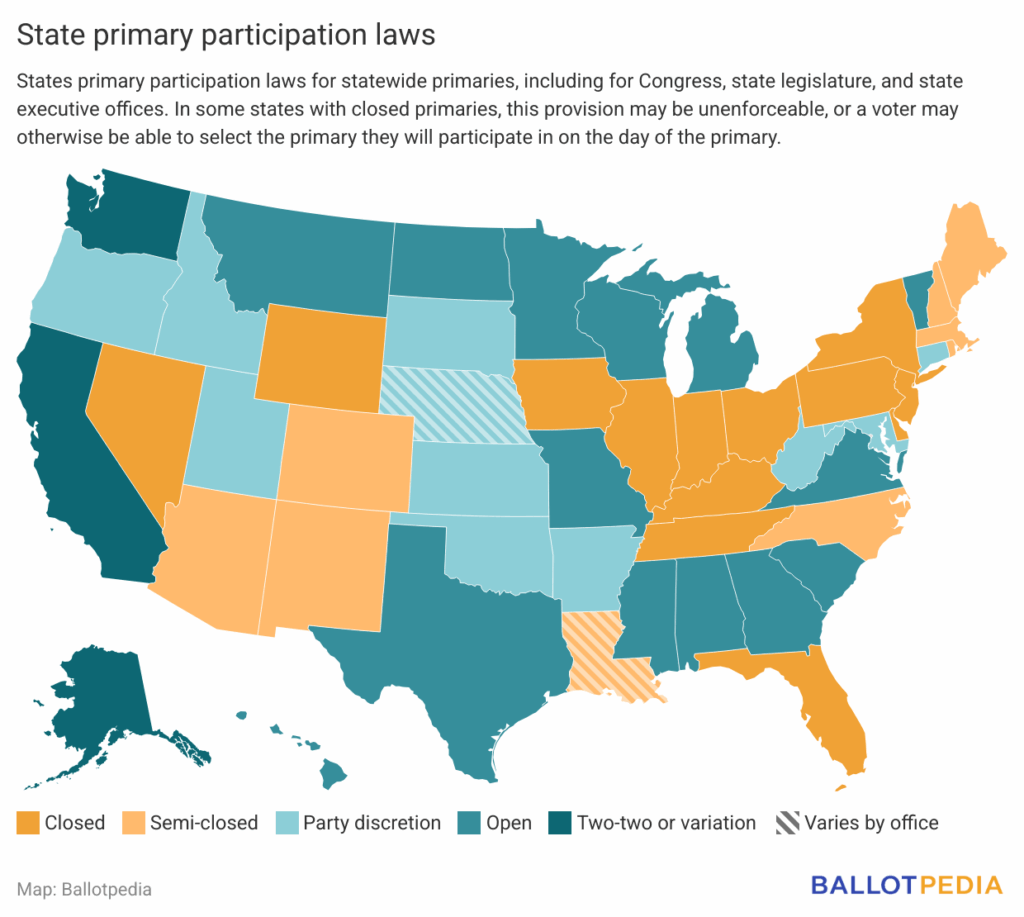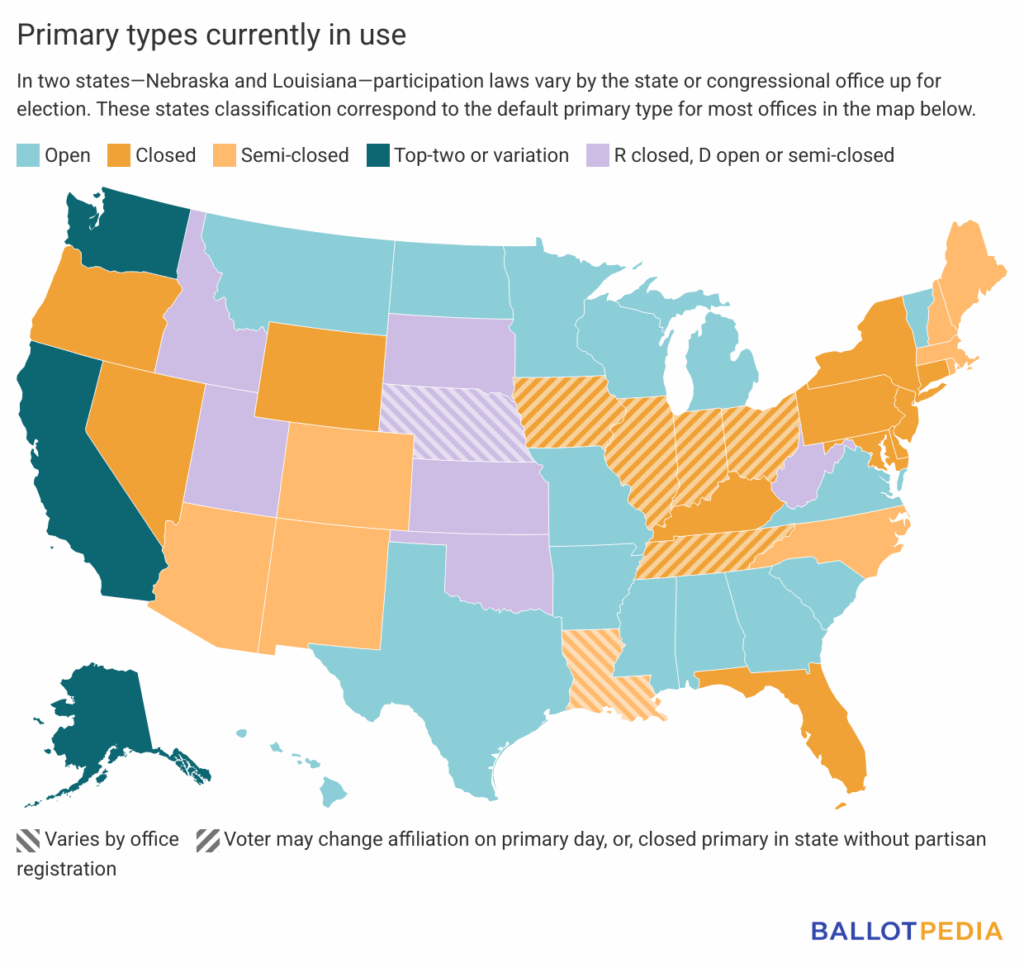Welcome to the Friday, Sept. 12, 2025, Brew.
By: Lara Bonatesta
Here’s what’s in store for you as you start your day:
- Understanding primaries – State primary laws and types, explained
- The surprising lessons from our school board listening tour, by Leslie Graves, Ballotpedia Founder and CEO
- Department of Labor announces ESG retirement plan rule
Understanding primaries – State primary laws and types, explained
State laws governing primaries can be confusing. In some states, political parties control their primaries, including whether to hold a primary at all. Elsewhere, primaries are mandatory. Lawmakers and voters also frequently amend primary rules, whether making minor changes or significant ones.
To understand the procedures governing primary elections, a voter needs to understand what state law says, what party rules say, and what this all means in practice.
Our new primary type hub page includes improved explanations and classifications of state primary laws and voter participation rules. This page covers two main topics: the laws that govern primary participation and outcomes, and the rules that major parties in each state use for their primaries.
Primary laws in the United States
Forty-four states require primaries for all statewide offices. Alabama, South Carolina, and Virginia allow parties to select their nominees without a primary.
Looking at laws governing who may participate in a primary, we classify states into one of five categories:
- Open: State law says that anyone can vote in this primary, regardless of partisan affiliation. There are no affiliation requirements before or after the primary.
- Closed: State law says a voter must be affiliated with a political party to participate in its primary. Note: In some states with closed primaries, it may still be possible for a voter to affiliate or change affiliation on the day of the primary.
- Semi-closed: State law says that voters who are not affiliated with a political party may participate in the partisan primary of their choice while retaining their status as an unaffiliated voter.
- Top-two or variation: State law says that all registered voters vote in the same primary, and all candidates are listed on the same ballot.
- Party discretion: State law permits parties to choose participation rules for their primaries.
Thirty-nine states require major parties to hold an open, closed, semi-closed, or top-two style primary for most congressional and state offices. Eleven states permit parties to choose between at least two possible primary types for most primaries. Of the 39 states where state law specifies a single primary type:
- Fourteen require open primaries.
- Thirteen require closed primaries.
- Nine require semi-closed primaries.
- Three require top-two style primaries.

Primaries in use
So what types of primaries do states actually use? In 40 states, both the Democratic and Republican parties use the same primary system for most or all statewide offices. In seven states, the parties operate different types of primaries. In Alaska, California, and Washington, there are no party primaries for congressional and state-level offices, and all partisan candidates compete in the same primary.
The Democratic Party uses:
- Open primaries in 18 states
- Closed primaries in 16 states
- Semi-closed primaries in 14 states
The Republican Party uses:
- Open primaries in 15 states
- Closed primaries in 23 states
- Semi-closed primaries in nine states

Several examples illustrate the need to keep state law, party rules, and other details in mind in order to understand a state’s primary system. While Tennessee requires voters to be affiliated with a party to participate in its primary, the state doesn’t have partisan voter registration. A voter must either be “a bona fide member” of the party or “[declare] allegiance to the political party” at the time of the primary.
In West Virginia, the Republican Party will hold a closed primary in 2026 — a change from previous elections in which it allowed unaffiliated voters to participate — while the West Virginia Democratic Party will continue letting independents vote in its nominating contests.
In Maryland, state law would permit non-party members to vote in party-run primaries, but neither the Democratic nor the Republican parties allow them to do so.
For more information on the complex landscape of primaries, check out Ballotpedia's hub for statewide primaries, and check out our Election Administration Legislation Tracker to stay up to date on the changes.
The surprising lessons from our school board listening tour

As you’ve been reading in the Daily Brew, Ballotpedia has released its findings from a year-long effort we conducted with local school board members — our “Virtual School Board Listening Tour,” or VSBLT.
In today’s column, I want to give you some background on the VSBLT, including why we did it, and some of the surprises we encountered in the course of that year of interviews.
First, the basics: we interviewed 100 school board members from 33 states. But those numbers only tell a fraction of the story behind the VSBLT.
That begins with a different set of numbers. As many of you know, Ballotpedia is celebrating its 18th birthday this year. For much of our existence, we focused on topics like statewide ballot measures, state legislators, members of Congress, and elections in larger cities and school districts. Three years ago, we really felt that we needed to cover the rest of the nation’s roughly 520,000 local elected officials — 83,000 of whom are school board members.
And so we dove right in, dedicating professional staff and volunteers to find out everything we could about these local officials that we, in turn, would share with voters so they could make informed decisions about who should hold those offices.
We soon realized we needed to do more than just gather information. We needed our staffers, writers, and researchers covering school board elections to become more deeply familiar with what it's like to be a school board member.
That was the genesis of the VSBLT. What happened when the interviews began was unexpected. It was fascinating and moving.
To start, 25 Ballotpedia staffers conducted these one-on-one interviews with school board members. What quickly emerged from these interviews was how intense some of them could be.
Most of us felt as if our interview was the first time anybody, including a family member, had really asked these school board members what it was like to serve.
The great majority of these people had a story to tell. It was very emotional for many of them to have a Ballotpedia staffer show a deep interest in their experience.
In the first interview I did with a school board member, we both started crying. I don't remember what got to us, but all of a sudden, we both got choked up.
There could be reasons for it — in most places in the country, school board members are essentially very busy volunteer positions that pay little or no money and yet consume huge amounts of every board member’s time. After attending to all their professional duties, when do they get time to process their experience?
They never do. That's one important thing we have learned from the VSBLT… that many school board members would like, and probably benefit from, the ability to talk about what it’s like to serve in this position.
And this fits into a much larger picture of our civic life. There are 520,000 of these local elected officials. They are just like everyone else, except they have taken on the responsibility of trying to solve problems, address issues, and balance the priorities of their friends, neighbors, and communities as best they can.
If everybody knew what these elected officials were doing and understood it, our civic life and our view of government would be much more positive.
Department of Labor announces ESG retirement plan rule
A version of this story appeared in our Economy and Society newsletter on Sept. 10. Click here to sign up.
On Sept. 4, the Department of Labor (DOL) announced its plans to issue a new rule governing the use of environmental, social, and governance (ESG) factors in Employee Retirement Income Security Act of 1974 (ERISA) retirement plans. The department’s Employee Benefits Security Administration listed the issue in its semi-annual regulatory agenda as being in the Final Rule Stage.
In case you're not familiar with the term, ESG investing is an asset management approach that considers environmental, social, and corporate governance practices. It's a type of stakeholder investing that says shareholder returns should not be the only goal. Stakeholder investing contrasts with traditional approaches that exclusively consider financial factors like balance sheets, income statements, and valuations to maximize risk-adjusted returns (also known as shareholder investing). To learn more about ESG and commonly considered investing factors, click here.
The Department’s position on ESG investing in retirement plans has shifted between administrations. In 1994, the Department of Labor began requiring fiduciaries to prioritize financial returns and material risk factors in their investment decisions. That continued with a number of rules and guidance documents the Department issued through 2020, all requiring plan managers to prioritize financial returns and risk mitigation factors in investment decisions but not prohibiting certain ESG investment considerations.
That year, the first Trump administration issued the Financial Factors in Selecting Plan Investments rule, which explicitly prohibited fiduciaries from considering ESG factors. In 2023, the Biden administration replaced that rule with the Prudence and Loyalty in Selecting Plan Investments and Exercising Shareholder Rights rule, which permitted ESG considerations. In May 2025, the second Trump administration announced it would no longer defend the Biden rule in the Fifth U.S. Circuit Court of Appeals.
Legal analysts expect the new rule will go through a full notice-and-comment process, even though it is listed in the Final Rule Stage.Ballotpedia covers ESG as part of our ongoing commitment to providing comprehensive, up-to-date political information beyond election coverage. To learn more about arguments for and against ESG, click here. For more information on federal rules and regulations related to ESG policy, click here.

